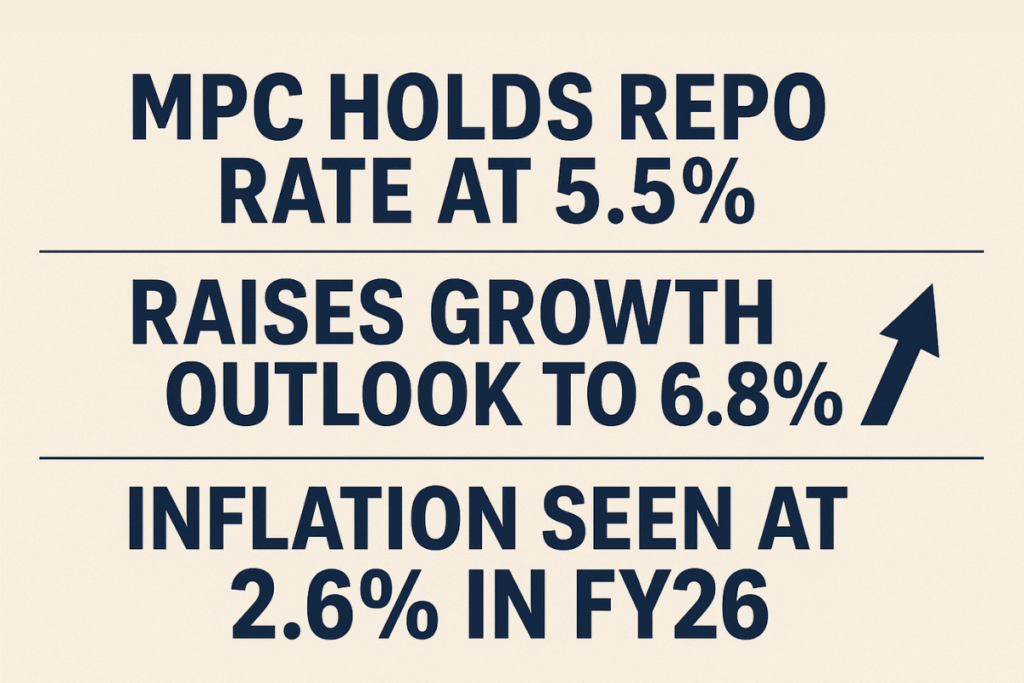Introduction
The Reserve Bank of India’s (RBI) Monetary Policy Committee (MPC) has once again held the repo rate steady at 5.5%, signaling a cautious yet optimistic stance towards India’s economic landscape. Along with maintaining the policy rate, the MPC has also revised India’s growth forecast upwards to 6.8% for FY26, while projecting inflation at 2.6%.
This decision comes at a critical juncture when India’s economy is showing resilience amidst global headwinds, volatile commodity prices, and shifting monetary policies across the world. By holding the repo rate, the RBI aims to balance between fostering growth and keeping inflation under control.
In this article, we will explore what the decision means, why it matters, and how it impacts different sections of the economy including households, businesses, and investors.
Key Highlights of the MPC Announcement
Below is a simple table presenting the essential information from the latest MPC policy:
| Parameter | Latest Decision | Previous Level | Remarks |
|---|---|---|---|
| Repo Rate | 5.5% | 5.5% | Rate unchanged |
| Growth Forecast (FY26) | 6.8% | 6.5% | Revised upwards |
| Inflation Projection | 2.6% | 3.1% | Revised downwards |
| Monetary Policy Stance | Neutral | Neutral | Continued cautious optimism |
| Liquidity Adjustment | No major changes | – | Adequate liquidity maintained |
| Reverse Repo Rate | 3.35% (unchanged) | 3.35% | Stability-focused |
Understanding the Repo Rate Decision
The repo rate, which stands at 5.5%, is the rate at which commercial banks borrow money from the RBI. When the repo rate remains unchanged, it indicates that the RBI is neither tightening nor easing monetary conditions drastically.
Keeping the repo rate steady suggests that inflationary pressures are manageable, but the RBI also does not want to risk overheating the economy by cutting rates. By maintaining the rate, the RBI aims to:
- Keep borrowing costs stable for businesses and households.
- Support ongoing economic recovery.
- Prevent inflation from flaring up due to excessive liquidity.
Growth Outlook: Why 6.8% Matters
One of the most striking aspects of the MPC’s decision is the upward revision of India’s growth forecast to 6.8% in FY26. This reflects optimism about:
- Strong domestic consumption.
- Expansion in manufacturing and services.
- Robust government capital expenditure.
- Global supply chain diversification benefiting India.
A higher growth outlook suggests a favorable environment for job creation, business expansion, and improved investor confidence.
Inflation Projection at 2.6%
Inflation is expected to moderate further to 2.6% in FY26, down from earlier projections of 3.1%. The decline is attributed to:
- Stable food prices.
- Improved supply chains.
- Softer global crude oil prices.
- Effective government interventions in commodity markets.
This low inflation level creates space for stronger growth momentum without eroding household purchasing power.
Impact on Different Stakeholders
1. Households
- EMIs: Since repo rate is unchanged, home loan and car loan EMIs will remain stable.
- Purchasing Power: With inflation at 2.6%, household budgets will face less pressure.
- Savings: Bank deposit rates may remain steady, providing moderate returns.
2. Businesses
- Borrowing Costs: Stability in interest rates helps businesses plan long-term investments.
- Consumer Demand: Higher growth forecasts translate to stronger demand for goods and services.
- Exports: Stable inflation and a competitive economy enhance export opportunities.
3. Investors
- Stock Market: The upward growth forecast is a positive signal for equity markets.
- Bond Market: With inflation moderating, bond yields may remain attractive.
- Foreign Investment: Stable policy and optimistic growth create favorable conditions for foreign inflows.
Global Context of RBI’s Decision
Globally, central banks such as the US Federal Reserve and the European Central Bank are still cautious, maintaining higher interest rates to combat inflation. In comparison, India’s inflation is well under control, giving the RBI more flexibility to support growth.
India’s strong domestic fundamentals, robust forex reserves, and controlled inflation have positioned it as one of the fastest-growing major economies in the world.
Sectoral Implications
Banking Sector
Banks will continue to lend at stable rates, maintaining profitability and asset quality.
Real Estate Sector
A stable repo rate helps keep housing demand steady, supporting both developers and buyers.
Manufacturing & Services
Growth optimism is likely to boost industrial activity, new project launches, and service expansion.
Agriculture
Lower inflation and stable credit conditions support farmers through affordable loans and predictable costs.
Challenges Ahead
While the MPC’s outlook is positive, certain risks remain:
- Global Oil Price Volatility – A sharp spike can push inflation higher.
- Geopolitical Tensions – Conflicts and trade disruptions may impact supply chains.
- Climate-related Risks – Extreme weather events can affect agricultural output and food prices.
The RBI will have to continuously monitor these challenges to ensure economic stability.
Future Outlook
Looking ahead, India’s economic path appears promising with a blend of strong growth and low inflation. If the projections hold, the country could witness:
- Increased foreign investment.
- Job creation across sectors.
- Stronger consumer confidence.
- Enhanced global competitiveness.
However, maintaining balance between growth and inflation will remain a delicate task for the RBI.
Conclusion
The MPC’s decision to hold the repo rate at 5.5% while revising growth upwards to 6.8% and lowering inflation projections to 2.6% highlights India’s steady macroeconomic progress. It sends a clear message that India is on a sustainable growth path, backed by prudent policy measures and strong domestic demand.
For households, businesses, and investors, this policy provides a stable and positive environment to plan ahead. Going forward, maintaining this balance will be crucial to ensuring that India’s economy not only grows faster but also in a more inclusive and resilient manner.

